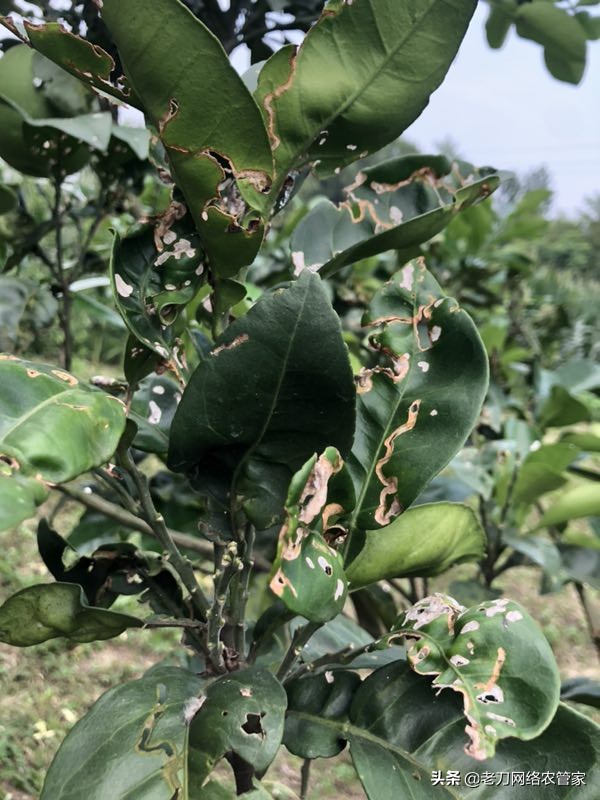The adult "latent leaf beetle" of grapefruit is oval in shape and has a central bulge on the back. The head , thorax dorsal plate , foot and antennae are black , the head is tilted forward , the back is centrally raised , the wing sheath and abdomen are orange , and the shoulder corners are black. Citrus producing areas south of the Yangtze River in China are distributed, endangering citrus.
This is not recently the user sent a picture of the citrus problem on the platform, asking: What is the situation of the expert? How is it treated?

▲Image from: Farmer Butler user
Experts give answers based on the pictures displayed:
Feng Tao (Lu'an City, Anhui Province, Agricultural Technology Station)
Latent leaf nail hazards It is recommended to use bifenthrin + alenazine or thiamethoxam spray control.
Guo Xinhua (Guan County, Liaocheng City, Shandong Province, Agronomist, Technical Station Manager)
Latent leaf beetle larvae are infested, with larger pores and obvious traces of excrement remaining in the pores. It can be sprayed with 20% cypermethrin emulsion, 2·5% cypermethrin emulsion, 2·5% cypermethrin emulsion or 20% cypermethrin emulsion 25000 to 3500 times liquid, once every 7 to 10 days, sprayed 1 to 2 times.
Lu Pengyuan (Southwest Forestry University, Zhengzhou, Henan)
Latent leaf methyl considers high-efficiency cypermethrin, perchlorothiazide, bifenthrin, bifenthiazide, bifenthrin thiazide, can be used.
Big classroom - recognize the pathogenesis of grapefruit leaf acess
1. Habitual symptoms
Adults live in groups, like to jump, have a pseudo-death habit, feed on young shoots and young leaves, and lay eggs on the back of young leaves or leaf margins. After the larva hatches, it drills into the leaves, meanders forward for feeding, and there is a black line formed by larval excrement in the center of the fresh worm path. After the larvae mature, they mostly fall with the leaves, bite the holes, and pupate in the loose soil around the trunk, and the depth of the soil is generally about 3 cm.
Second, the law of pathogenesis
In South China, 2 generations occur a year, and in Zhejiang, 1 generation occurs, with adult insects overwintering in the soil or under the bark. Activities begin in late March to early April, lay eggs in early to mid-April, infestation periods in early to mid-May, pupate in early and mid-May, feathering of adults in mid-to-late May, and hibernation in early June.
3. Agricultural prevention and control
In general, the occurrence garden uses medicine to prevent and treat red spiders once around April 15, and the re-occurrence garden can start the drug 2-3 days before the peak of egg hatching. At the same time, two medications are required, and the second medication is mainly for the treatment of bud maggots, supplemental treatment or provocative treatment of latent leaf beetles, red spiders, prevention of macular disease, anthrax and so on.
Fourth, grapefruit latent leaf A medication reference
2.5% cypermethrin microemulsion (moderately toxic) use 20-40 ml/mu spray
40% Chlorpyrifos Micro Emulsion (Moderate Toxicity) use 1500-2000 times liquid spray
40% carbonitrile. Pyridoxine suspension (moderately toxic) use 24-30 ml / mu spray
20% acetidium pyridine microemulsion (moderately toxic) use 20-25 ml/mu spray
15% pyridine microemulsion (moderately toxic) use 75-100 g/mu spray
25% thiamethoxine water dispersible granules (low toxicity) use 10-15 g/mu spray
45% malathion emulsion (low toxicity) use 80-110 ml/mu spray
20% cyanogen dichlorvos Emulsion (low toxicity) use 50-75 g/mu spray
20% per chlorine equisa emulsion (low toxicity) use 60-86.6 ml/mu spray
50% Dichlorvos Horse Emulsion (Moderate) Use 750-900 times liquid spray